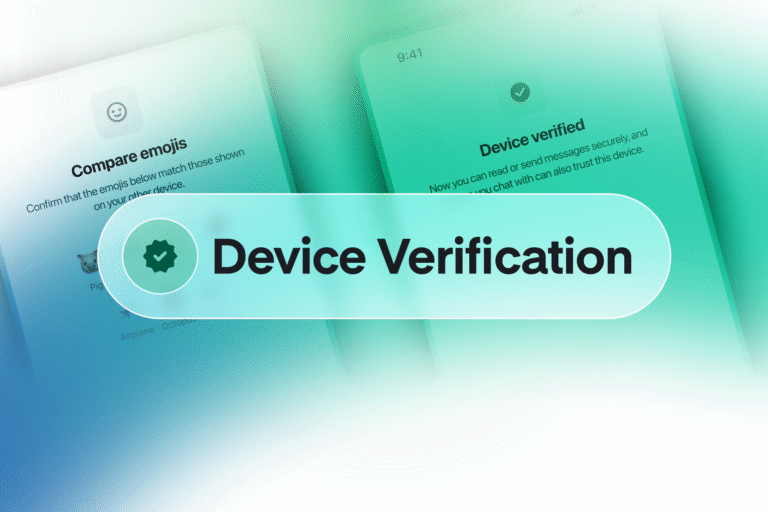Verifying your Matrix devices is becoming mandatory
Act now: continue sending & receiving encrypted messages
In April 2026, we will be rolling out a significant update to strengthen the security of your conversations: unverified devices will no longer be able to send and receive end-to-end encrypted messages via Element. This change follows the Matrix specification update that was announced at the Matrix 2025 conference on October, 17 and benefits everyone by enhancing security, but may require an action from you to continue sending & receiving encrypted messages on your existing devices.
This security update will give you assurance that when you receive a message from a contact, you can effortlessly assume it’s really from them.
It’s a big step towards making Element an even more safe and reliable messaging experience. We mean it when we say that we want to provide the most secure communication technology in the world.
So here’s what’s changing and why it matters to you.
Unverified devices are a potential attack vector
Imagine you’re messaging a colleague and suddenly a warning shield icon appears on your screen. Is this just a harmless unverified device and you can safely ignore the warning, or has someone’s account been compromised? At best this is a distraction and, at worst, it is someone malicious trying to impersonate one of your contacts – neither is ideal. What’s worse is that ignoring these warnings leaves unmitigated risks to proliferate throughout your network.
With Element, trust is critical – a non-negotiable. For example, we provide end-to-end encryption by default to all of our users to ensure that you and the person you’re messaging – and only the person you’re messaging – can read the messages. This forthcoming change aims to eliminate uncertainty and the likelihood of malicious activity by requiring all devices to be verified.
Device verification matters
Device verification acts like a hand shake between your devices, proving cryptographically to your contacts that they belong to you. Without this verification step, messages sent from your new devices must be marked as untrusted in your conversations. By making verification mandatory, users can be confident in every message sent and received via Element and are not distracted by warnings about insecure devices.
Trust by design and default
Going forward devices will be either verified or unable to participate in conversations – it’s that simple. No more warning or shield icons that can be easily ignored, these ultimately undermine the impact of important warnings/notifications (users become desensitised).
By verifying your devices, you’re not just protecting your own communications, you’re creating a more trusted environment for everyone.
We’re designing a system that prioritises the security of your communications and making verification an integral part of the process is a great example of that.
Action required by end users
If you’re already in the habit of verifying your devices and have your recovery key set up there’s nothing you need to do to prepare, you’re good to go.
For everyone else, now is the time to take action:
- Check if your existing devices – mobile, web or desktop – are verified.
- Set up recovery if you haven’t done that already.
Note: although setting up recovery is strictly not mandatory, it is highly recommended, as it simplifies the verification of new devices, and enables you to do that even when you lose all of your current devices.
For the details of how to do this on various platforms, please read more in the user documentation.
What if you don’t verify…?
From April 2026:
- Unverified devices will no longer be able to send messages.
- Content of the messages received from unverified devices will not be shown (you can still see that there was a message).
In short, unverified devices will effectively become unusable in end-to-end encrypted (E2EE) conversations. You’ll still be able to participate in conversations where E2EE has been deactivated, but in all other circumstances you will be excluded.
Building trust together
As stated above, trust is fundamental to secure communication. By requiring verified devices, we are raising the bar for what users can expect from your secure communication. This is a small change that makes a big difference. We have to work together with our users to ensure success. We’re doing this work to ensure every message you send and receive is as trustworthy as a face-to-face conversation.
We’re here to make the transition as smooth as possible. If you have questions or need help, our support team is ready to assist. Together, let’s make digital communication as secure as possible for everyone.

